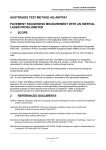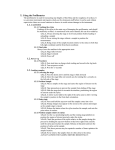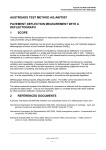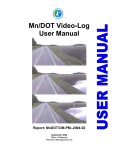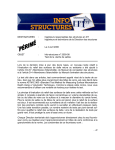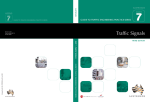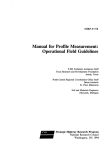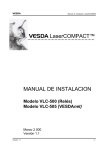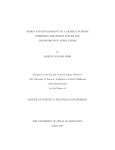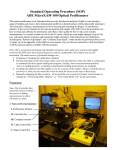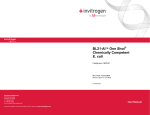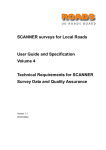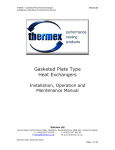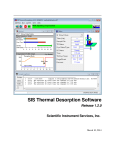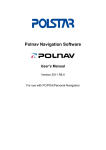Download austroads test method ag:am/t013 pavement surface texture
Transcript
Austroads Test Method AG:AM/T013 Pavement Surface Texture Measurement with a Laser Profilometer AUSTROADS TEST METHOD AG:AM/T013 PAVEMENT SURFACE TEXTURE MEASUREMENT WITH A LASER PROFILOMETER 1 SCOPE This test method defines the procedure for measuring the surface macro-texture of road pavements, determined by the direct measurement of the road surface profile using a laser-based non-contact device (i.e. a laser profilometer) mounted on a vehicle. The macro-texture of the pavement surface may be recorded as either Mean Profile Depth (MPD) or Sensor Measured Texture Depth (SMTD) depending on the equipment and analysis method used. These measures have a strong linear relationship to volumetric methods such as the sand patch test method that are also used to measure texture depth and correlation equations may be employed to convert both MPD and SMTD to equivalent manual measurements. A single test result produced by this method is the average surface texture over a given length of road (typically 20 or 100 m).Laser profilometers used in accordance with this Test Method are operated by a designated ‘operator’, who is responsible for all aspects of the test and, usually, a vehicle ‘driver’. The driver is responsible for driving the profilometer vehicle in a safe and legal manner. This test is often conducted in conjunction with the measurement of road pavement roughness and rutting. This test method does not address all occupational health and safety issues associated with its use. It is the responsibility of the user to operate in accordance with appropriate legislation. Annex 1 of this Test Method outlines, in general terms only, some of the hazards and precautions relevant to the use of lasers in road condition measurement. This information has been included to raise awareness of issues and does not override safety warnings/procedures specified by equipment suppliers or other relevant work practices or standards. Refer to equipment documentation and AS 2211:2004 (Standards Australia 2004) for further information. 2 REFERENCED DOCUMENTS ASTM E 1845 (2009). Standard practice for calculating pavement macrotexture mean profile depth. ASTM International. Austroads Test Method AG:AM/T014. Validation of a laser profilometer for measuring pavement surface texture (reference device method). April 2011. Austroads Test Method AG:AM/T015. Pavement surface texture validation checks for a laser profilometer (loop method). March 2011. Austroads Test Method AG:PT/T250. Modified surface texture depth (pestle method). June 2008. Austroads 2011 —1 — Austroads Test Method AG:AM/T013 Pavement Surface Texture Measurement with a Laser Profilometer International Organization for Standardization (ISO) 2007, International vocabulary of metrology -- basic and general concepts and associated terms (VIM), ISO/IEC Guide 99, 3rd edn. International Organization for Standardization (ISO) 2005, Quality management systems – fundamentals and vocabulary, ISO 9000:2005. International Organization for Standardization (ISO) 13473-1 (2004). Characterization of pavement texture by use of surface profiles – part 1: determination of mean profile depth. Standards Australia 2004, Safety of laser products: equipment classification, requirements and users guide (IEC 60825-1:2001, MOD), AS/NZS 2211.1:2004, Standards Australia, Sydney, NSW. 3 (a) DEFINITIONS Pavement macro-texture The deviations of the surface profile of the pavement from a true planar surface with the characteristic dimensions of wavelength and amplitude from 0.5 mm up to those that no longer affect tyre-pavement interaction (≈ 50 mm). (b) Surface profile A two dimensional representation of the pavement surface shape measured normal to the surface plane and recorded spatially at equal intervals along the direction of traffic flow. (c) Laser profilometer A laser profilometer (or laser profiler) is a vehicle fitted with a laser-based measurement system that records the shape of the pavement surface profile. (d) Wheelpath The wheelpath is the lateral or transverse location of the survey vehicle’s tyre within the survey lane. (e) Mean profile depth (MPD) A mean measure of macro-texture where the pavement surface profile is divided into small segments of a given base length, typically 100 mm, which are analysed and the mean segment depths averaged to give an average value for a specific length of profile. (f) Sensor measured texture depth (SMTD) A continuous measure of macro-texture where the pavement surface is divided into smaller segments of a given base length, approximately 300 mm long, which are analysed, assigned a value and averaged to give a mean value for a specific length of profile. (g) Volumetric texture measurement A manual method usually involving the spreading of a known mass or volume of sand or glass beads, of a specific grade over the pavement surface. By dividing the volume of material by the area covered a value is obtained which represents the average depth of the layer. (Refer to Austroads Test Method AG:PT/T250). (h) Portable texture meter A portable laser based device capable of measuring pavement surface macro-texture e.g. the Texture Meter 2 manufactured by WDM Ltd or the Stationary Laser Profiler designed by Transit New Zealand. Austroads 2011 —2 — Austroads Test Method AG:AM/T013 Pavement Surface Texture Measurement with a Laser Profilometer (i) Calibration ISO (1993) defines ‘calibration’ as: [a] set of operations that establish, under specified conditions, the relationship between values of quantities indicated by a measuring instrument or measuring system, of values represented by a material measure or a reference material, and the corresponding values realised by [measurement] standards. (j) Validation ISO (1994) defines ‘validation’ as: confirmation, through the provision of objective evidence that requirements for a specific intended use or application have been fulfilled. 4 EQUIPMENT The following equipment is required: (a) A laser profilometer consisting of the following: A vehicular platform capable of transporting testing equipment, mounting the surface profile measuring equipment and travelling at a range of speeds up to the limit of the operating range of the surface profile measuring equipment. A laser based displacement transducer operating at sufficient speed to measure the distance between the laser and the travelled surface at the specified interval (≥ 64 kHz for MPD and ≥ 16 kHz for SMTD). The spot size of the laser must be less than or equal to the specified sampling interval. The displacement transducer(s) shall be mounted to ensure mid-range operation during normal operation. The surface texture is to be measured at two locations; between the wheelpaths (defined as the mid-point of the vehicle) and in the outer wheelpath. By definition the outer wheelpath laser must be located anywhere from a minimum of 750 mm up to a maximum of 1100 mm from the mid-point of the vehicle. Measuring the surface profile in the inner wheelpath is optional. A distance measuring transducer capable of measuring the distance travelled to an accuracy of ±0.1%. The transducer shall provide input to the data logger to record the distance travelled from the start of the collection survey. A data logger capable of capturing the output data from the transducers at known equal intervals at speeds up to the maximum survey speed, within the range of wave lengths of 0.5 mm and 50 mm. The sample interval shall not be greater than 1 mm for MPD and 10 mm for SMTD. A processing computer to analyse the surface profile data and to apply the appropriate algorithm to obtain MPD or SMTD for each measurement path. (b) Manufacturer’s User Manual. (c) Flat base plates, gauge blocks and any other equipment required by the manufacturer’s User Manual for the calibration of the laser displacement transducers. Austroads 2011 —3 — Austroads Test Method AG:AM/T013 Pavement Surface Texture Measurement with a Laser Profilometer 5 CALIBRATION AND VALIDATION 5.1 Equipment Validation 5.1.1 Distance Transducer (a) The distance transducer must be calibrated in accordance with the manufacturer’s specification. (b) The calibration factor and associated information, such as the date and time of calibration, is then stored and used for all subsequent testing until such time as a new distance calibration is performed. (c) Distance calibration must be performed whenever a distance transducer is fitted on the vehicle and immediately following any change to the distance transducer or change to any part of the host vehicle that may interfere with the existing calibration constant (e.g. change of wheels or tyres). 5.1.2 Laser Displacement Transducers (a) The laser displacement transducers must be calibrated in accordance with the manufacturer’s requirements (refer manufacturer’s User Manual). (b) The transducers must be calibrated immediately following any change to the laser transducers or a change to any part of the host vehicle that may interfere with the existing calibration. 5.2 System Validation A system validation must have been undertaken. In the absence of other specified requirements, the following must be applied: (a) Validation of distance measurement must be conducted in accordance with AG:AM/T005. (b) Validation of texture measurement must be carried out in accordance with Austroads Test Method AG:AM/T014 or Test Method AG:AM/T015. (c) At any stage during a data collection exercise the last successfully passed validation must be within the last 12 months. 6 PROCEDURE 6.1 Pre-test Set-up (a) If the laser equipment is of a demountable design, calibrate the vertical distance transducers using the step gauge block and flat plates each time the lasers are refitted to the vehicle. (b) Ensure that the serial numbers (or other information that allows traceability to calibration documentation) are recorded for all sensors. (c) Perform manufacturer’s operational validation procedure (‘bounce test’) (refer to Section 6.2, and manufacturer’s User Manual). (d) Ensure that all appropriate warning devices and equipment are in place and operational. 6.2 Operational Validation Procedure Follow the manufacturer’s operational validation test which must be performed before the start of each day’s testing (refer manufacturer’s User Manual). Austroads 2011 —4 — Austroads Test Method AG:AM/T013 Pavement Surface Texture Measurement with a Laser Profilometer 6.3 Profile Survey (a) The operator shall follow manufacturer’s instructions for use of the equipment (refer manufacturer’s User Manual). (b) The lane to be surveyed is called the ‘test lane’. For routine network surveys, unless otherwise directed, the test lane shall be that lane that is used by the majority of the traffic. For most roads this coincides with the outer/slow/kerb lane. The median lane shall be tested if parked vehicles obstruct the outer lane; this must be noted and reported. (c) The vehicle must be driven in the usually trafficked wheelpaths. (d) Ensure the vehicle is travelling within the manufacturer’s operational speed range prior to the defined start point of the survey. (e) Throughout the survey the vehicle must be driven in a smooth manner, and care must be taken to ensure that the speed of travel is within the manufacturer’s operating range wherever possible. (f) Data must be collected with reference to the pre-specified referencing system, and the location of any reference points measured during the survey noted in the data reporting. The start point of the survey must be defined prior to commencing the survey. (g) Following the instructions in the manufacturer’s User Manual, measure the surface profile in the outer (passenger side) wheelpath and between wheelpaths of the test lane, travelling at a relatively constant speed, with the centre of the vehicle coinciding with the mid-point between the wheelpaths of the lane being surveyed. (h) If the surface texture data is not collected along the full length of the pavement, but rather within a sample length of the pavement, then this must be noted and reported. (i) Testing must be terminated if conditions are such that difficulty is encountered maintaining the required test lane and/or minimum test speed resulting in the collection of invalid data. (j) No attempt should be made to avoid pavement defects unless they are likely to damage the vehicle and/or jeopardise safety. (k) Testing must not be performed during periods of rain or where the road surface is wet. If a localised section of wet road is encountered it must be noted and/or flagged (Section 6.4). Arrangements shall be made to test the section when weather conditions are more favourable, if required. 6.4 (a) Factors Affecting the Test There are a range of factors that may affect texture measurements, and when encountered during surveys, the relevant test result must be marked and reported with a note or flag. Example factors include: deviation from the test lane test speeds outside the operating range of the equipment, especially low speeds hard acceleration/deceleration/cornering tortuous road geometry bridge abutments/expansion joints cattle grids timber/grid bridge decks Austroads 2011 —5 — Austroads Test Method AG:AM/T013 Pavement Surface Texture Measurement with a Laser Profilometer (b) rail tracks and crossings access pit covers local area traffic management installations, e.g. speed humps, roundabouts, etc. localised areas of free standing/flowing water on the road surface localised areas of contamination of the road surface, e.g. mud, debris, etc. Record any unusual features and events that might influence the results. 7 CALCULATIONS 7.1 Mean Profile Depth (MPD) Calculations shall be made in accordance with ASTM E1845 or ISO 13473-1:1997. 7.2 Sensor Measured Texture Depth (SMTD) Calculate the following for each transverse location (i.e. the outer wheelpath, between the wheelpaths, and optionally the inner wheelpath): (a) Divide the surface profile into segments consisting of 40 contiguous samples. The resultant base length of the segment is equal to 40 times the sample interval. For consistency, it is recommended that the sample interval be close to 7 millimetres. (b) Fit a second order polynomial (ye) using a quadratic least squares regression to the 40 contiguous samples and calculate the value of the residuals (yi – ye). (Figure 7.1). yi y5 y2 y40 y4 y1 ye = a + bx + cx2 y6 y3 Figure 7.1: Calculating sensor measured texture depth (c) Calculate the SMTD for each segment using the following equation: SMTD y y 40 i 1 i 2 e 40 Note: SMTD is equivalent to the Root Mean Square (RMS) value of the residuals for each segment. Austroads 2011 —6 — Austroads Test Method AG:AM/T013 Pavement Surface Texture Measurement with a Laser Profilometer (d) 7.3 Aggregate the individual SMTD results and report the arithmetic mean value calculated for each specified test interval (maximum length is 100 metres). Equivalent Sand Patch Texture Depth (SPTD) Both MPD and SMTD may be converted to an equivalent volumetric sand patch texture depth. This will be dependent on first performing a correlation exercise under controlled conditions to develop a relationship between the results achieved using the volumetric test method and MPD or SMTD. MPD may also be directly calculated from SMTD by firstly deriving a relationship between SMTD and Sand Patch Texture Depth (SPTD), also known as estimated texture depth or ETD, and then transposing the following equation: ETD 0.8 MPD 0.2 Note: Refer to ASTM E1845 or ISO 13473 for further information. 7.4 Effect of Speed Surface texture measurements made by laser profilometers are often influenced by the speed of the test vehicle. If the effects of speed on texture measurements have been quantified for the test profilometer it is recommended that the test results are corrected using a speed correction factor. If such a correction is not made, a statement indicating that the test results may be affected by speed must be included with the reported results. 8 REPORTING For each test run, the following data must be recorded but not necessarily reported: (a) survey title/contract number (b) date and time (c) survey device identification (d) operator (e) driver (f) road number/reference (g) road name (if applicable) (h) test direction (i) test lane (j) start and end references (k) intermediate features and/or reference points (if applicable) (l) any unusual occurrences (e.g. lane changes, bridge abutments, end of seal, etc.) (m) type of surface texture measurement (e.g. MPD or SMTD) (n) percentage of pavement continuously sampled (o) position of surface texture measuring lasers. Austroads 2011 —7 — Austroads Test Method AG:AM/T013 Pavement Surface Texture Measurement with a Laser Profilometer For each test result: (a) between wheelpaths surface texture (to the nearest 0.1 mm) (b) outer wheelpath (passenger) surface texture (to the nearest 0.1 mm) (c) equivalent sand patch texture depths – optional (to the nearest 0.1 mm) (d) vehicle speed during test (e) error or event flags (f) operator comments where applicable. Austroads 2011 —8 — Austroads Test Method AG:AM/T013 Pavement Surface Texture Measurement with a Laser Profilometer AUSTROADS TEST METHOD AG:AM/T013 PAVEMENT SURFACE TEXTURE MEASUREMENT WITH A LASER PROFILOMETER ANNEX 1 – LASER SAFETY INTRODUCTION Lasers used in road condition measurement systems can present a risk of injury if they are operated incorrectly. This Annex outlines, in general terms only, some of the hazards and precautions relevant to the use of lasers in road condition measurement. This information has been included in order to raise awareness of issues. It does not override safety warnings/procedures specified by equipment suppliers or other relevant work practices, requirements or standards. Refer to AS2211:2004 (Standards Australia 2004) for further information. The lasers used in profilometers are classified as Class 2, 3B or 3R lasers (Standards Australia, 2004) and may be visible (having a wavelength less than 700 nanometres (nm)) or invisible/infrared (wavelength greater than 700 nm). PERSONNEL Only trained personnel should operate laser equipment. Personnel unfamiliar with laser safety procedures must be kept away from operating lasers by verbal instruction or by use of warning signs, screens or other hazard warning devices. RISKS The extent of damage that lasers can cause to the eye or skin is dependent upon the duration of exposure. Due to its concentrated nature, laser light, whether visible or invisible, can cause damage to the eye before the eye can avoid exposure by blinking or looking away. The major difference between exposure to the eye or skin is that the eye focuses the laser light onto the back of the eye. There are two types of eye injury that can result from exposure to laser light: (a) thermal injury – heat from the laser light causes a change in proteins in the eye, similar to the change in egg white that occurs when an egg is cooked; this damage may or may not be permanent (b) thermal-mechanical injury – heat from the laser light causes blood vessels in the eye to rupture; this damage cannot be repaired. Austroads 2011 —9 — Austroads Test Method AG:AM/T013 Pavement Surface Texture Measurement with a Laser Profilometer LASER IDENTIFICATION Lasers are identified by a number of warning labels, including warning symbols, class identifiers, wavelength labels and aperture markers. The laser aperture marker indicates the aperture through which the laser is emitted. Before testing, calibrating or using a laser system it is important to be aware of the location of all laser apertures. Wavelength labels indicate the wavelength (nm) of the emitted laser light. Laser safety glasses and laser indicator cards must be selected to match the wavelength of the laser with which they will be used. Laser indicator cards must be used when determining the direction of a laser beam. Cards used must be appropriate for the wavelength of the lasers. Safety glasses, suitable for the wavelength of the lasers, must be worn when using laser indicator cards. JEWELLERY AND OTHER REFLECTIVE OBJECTS It is important that reflective objects not be put in the path of an operating laser beam. When checking, testing or calibrating a laser all jewellery (watches, rings, etc.) must be removed from the hands and wrists. CALIBRATION BLOCKS AND PLATES Laser system manufacturers usually supply calibration blocks/plates with their equipment, and it is important that only these blocks/plates be used for calibration. The surface finish of these blocks is manufactured to provide a diffuse reflection of laser beams, reducing the risk of exposure to damaging levels of laser radiation. Austroads 2011 — 10 — Austroads Test Method AG:AM/T013 Pavement Surface Texture Measurement with a Laser Profilometer AMENDMENT RECORD Amendment No. 1 (Initial release) 2 (Revised release) 1 Sections amended Action (1) All (Richard Wix & Michael Moffatt, ARRB) All (Richard Wix & Young Choi, ARRB, project AT1484) Key: Format change in format Substitution old section removed and replaced with new section New insertion of new section Removed old section removed Austroads 2011 — 11 — New Substitution Date 26 March 2007 2 March 2011











